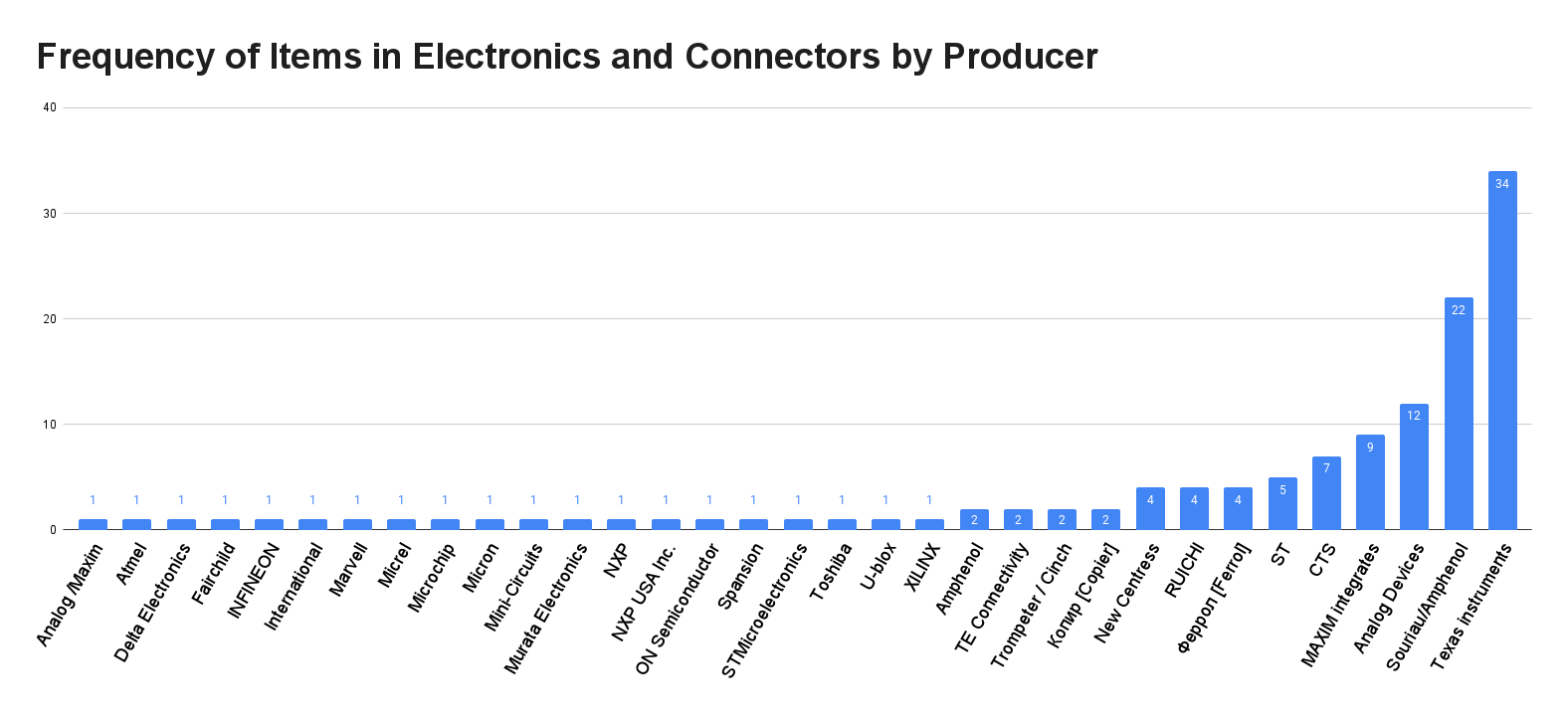David Albright and Sarah Burkhard
Shahed-136 kamikaze drones, filled with Western electronics, continue to destroy Ukrainian lives and their civilian infrastructure. These drones, also known as Geran 2, are produced and assembled at JSC Alabuga facilities inside the Alabuga Special Economic Zone in Russia, with assistance from Iran. Yet, the company responsible, JSC Alabuga, 1 and related companies are still not found on public U.S. or allied sanctions lists.
Information in internal Alabuga documents, analyzed by Institute staff over hundreds of hours, show a remarkable ability to acquire sophisticated electronic components from the West and build modules aimed at defeating Ukraine’s ability to jam Shahed-136 drones and require Ukraine and its allies to keep deploying additional or more advanced jamming systems. The detailed information on the Shahed-136’s electronic components, with part numbers and manufacturer, provide a valuable opportunity to thwart exports of these specific parts to Russia and its partner Iran, which has to date supplied most of these electronic parts to Alabuga for use in the Shahed-136 drone. Starting next year, however, Alabuga has committed to outfit Shahed-136 drones with electronic components it acquires on its own.
The danger posed by Alabuga should mobilize governments to apply sanctions and other restrictive measures to Alabuga and the associated companies revealed in the documents. Sanctions on Alabuga would not only be helpful in disrupting Alabuga and associated companies’ procurement efforts, but they would cause stress to a giant drone factory that has to produce thousands of Shahed-136 drones on a tight schedule, with little previous experience with drone production, hundreds of new employees on its payroll, and under financial pressure to prove itself as a capable supplier to the military.
The internal Alabuga documents contain detailed information about the types and origins of electronic components in the Shahed-136 kamikaze drone. While other Shahed-136 components, such as servomotors and certain raw materials, are also critical items that Alabuga and Iran acquire abroad, and need to be tightly controlled, almost all of the electronic components are made exclusively in the West and also lie at the heart of the Shahed-136’s ability to evade Ukrainian jamming and reach their targets. One electronic module in the Shahed-136 drone called Nasir in the documents was designed by Iran and has played a central role in hindering Ukrainian jamming efforts. The documents indicate that Nasir has state-of-art antenna interference suppression, i.e. suppressing enemy jamming signals while preserving the desired GPS signal. It works with other modules listed in Table 1.
To build Nasir and the other four associated major electronic modules in each Shahed-136 drone, Alabuga and Iran need to import large quantities of electronic components. One document contains an extensive list of about 140 electronic and connector components in each Shahed 136, created by Alabuga with Iranian data in late 2022 or early 2023, revealing Alabuga’s (and Iran’s) dependence on successfully obtaining from abroad these components. Figure 1 shows a distribution of manufacturers of electronic components and connectors in this list. Many of the electronic components are made exclusively in the West and by its allies; about 80 percent originate in the United States. While Alabuga is expected to seek substitute components, reacting to sanctions and supply chain disruptions, a significant number of these components are not made in Russia, Iran, or China and will still require access to Western electronic goods.
There are reasons to believe the technology underlying Nasir has aided other Russian weapons’ anti-jamming systems. For example, the miniaturized versions of the Kometa anti-jamming systems could have been one beneficiary. These Iranian capabilities diminish Ukraine’s ability to defend its airspace.

Figure 1. Frequency of components by producer appearing in an Alabuga Excel spreadsheet for the Shahed 136 navigation modules, anti-jamming modules, flight control unit, and power distribution unit. Connectors are also included. The names of producers are taken directly from the Excel sheet and may include companies that have since merged or changed their name.

The information in the Alabuga documents justifies manufacturers, distributors, and customs as well as enforcement officials in the U.S. and allied countries taking extraordinary steps to make it harder for Alabuga (and Iran) to succeed in acquiring these items, including opportunities to disrupt Russia’s and Iran’s efforts to use covert supply channels. The U.S. Bureau of Industry and Security has already implemented a range of important and effective measures to better control needed items and enlist other countries in doing so as well. Toward more effective efforts to stifle Alabuga, governments can create more precise information about which specific parts and in what quantities Alabuga needs for its drones, allowing for more targeted warnings to customs agencies, the financial sector, other governments, manufacturers, distributors, and logistic and transportation providers.
In parallel, manufacturers and their foreign subsidiaries as well as their distributors, logistic and transportation providers, should be put on high alert with respect to the highest priority items, in particular electronic integrated circuits. They stand out as a common item in the Alabuga electronic component list, which lists over 50 of them of many varieties out of the 140 on the entire list of electronic components and connectors. Companies selling the most critical components, in some cases identified by Alabuga itself, such as at least one sold by Texas Instruments, should stop using distributors to sell these specific parts. Instead, the company and its subsidiaries should sell them directly, which would allow for centralized internal compliance systems to catch suspicious inquiries and for more thorough checks of declared end-uses and end users.
But all of these efforts need to be underpinned by sanctions on Alabuga and its related companies. The United States and its allies should apply them as soon as possible.
No comments:
Post a Comment